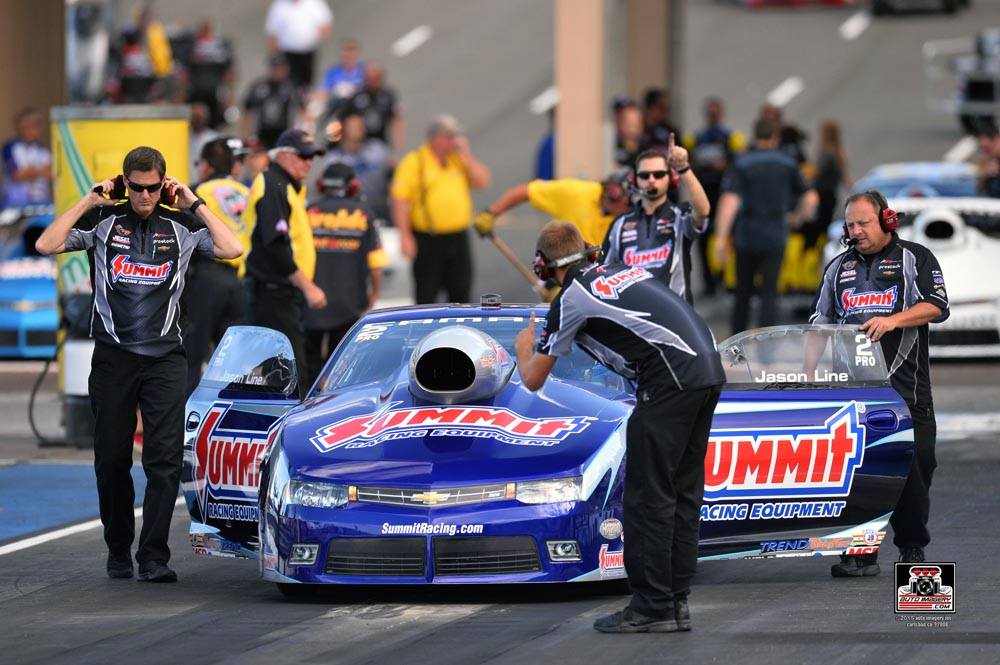Citing Pro Stock racing’s need to “evolve from a technological standpoint, yet reconnect with its roots,” NHRA has announced major changes to its factory hot rod class. The changes will take place in two phases, with the major changes taking effect on Jan. 1, 2016. At that time, NHRA will require all Pro Stock teams to:
- Equip cars with electronically controlled throttle body fuel injection, along with a 10,500 rpm rev limiter.
- Remove all hood scoops and reduce the length of wheelie bars to a length specified by the NHRA Tech Department.
The changes are being made to make the race car design’s more relevant and boost spectator appeal by “increasing the unpredictability of the class through more ‘wheels up’ launches.”
Other changes, which go into effect at this weekend’s NHRA Sonoma Nationals, will require teams to back their cars into the pits and keep the engines uncovered for spectators to view. Crew members will now also be prohibited from standing beside the cars and holding them in place as they begin their burnouts. And finally, NHRA will require manufacturer identification headers to be visible on the windshields of all cars.
You can see the entire statement from NHRA below.
What are your thoughts? Are the changes good or bad?
NHRA has announced a series of changes for the Pro Stock category designed to increase spectator appeal, make the class more relevant from a technology standpoint, and to enhance the overall pit experience for fans of the 200-mph factory hot rod class.
The changes will be mandated in two waves. Three changes will take effect at the NHRA Sonoma Nationals, July 31, 2015, while several others will not take effect until the 2016 NHRA Mello Yello Drag Racing Series season.
The three changes that are effective at Sonoma are designed to increase spectator appeal and enhance the overall pit experience for fans.
NHRA will require teams to back their racecars into the pits and leave engines uncovered so that spectators have better accessibility to see the racecars and interact with the drivers and crew members. A new rule also will discontinue the practice of crew members standing beside the cars to hold them in place as they begin their burnouts. Finally, NHRA will make it mandatory for teams to create automobile manufacturer identification headers visible on the racecars’ windshields up to a maximum of 4.5-inches high, but not smaller than 4.25-inches.
Starting on Jan. 1, 2016, NHRA will require all Pro Stock teams to equip their cars with electronically-controlled throttle body fuel injection systems, making engines more relevant from a technology standpoint. In order to reduce and control costs for the race teams, an NHRA-controlled 10,500 Rev Limiter will be added to the fuel injection systems.
NHRA also will require Pro Stock teams to remove all hood scoops and reduce the length of the wheelie bars to a length specified by the NHRA Tech Department. Those changes are designed to make the racecar designs more relevant and to boost spectator appeal by increasing the unpredictability of the class through more “wheels up” launches from the starting line.
In addition, NHRA will work with new television partner FOX Sports to improve coverage and maximize exposure of the Pro Stock category through increased driver and team profiles and technical features, in addition to expanded on-track racing coverage.
“Pro Stock racing has a tremendous history with NHRA and proves each weekend by the close side-by-side finishes that it is one of the most competitive forms of racing in all of motorsports,” said Peter Clifford, NHRA president. “Through these changes we hope to provide a platform so the Pro Stock class can evolve from a technological standpoint, yet reconnect with its roots by generating more interest and appeal among spectators.”


if its not life threatning,and I enjoy it more IMM FOR IT.
I have always wanted them to go back to factory body’s. That is shape, size, Just like the original Pro stock.
Love it as long as they are safe. I think they should go back to factory style bodies.
It seems that they’ve just become Funny Cars, part deux. I think it is a step in the right direction. The originals were fantasy street cars, not airbrushed rockets–Gapp and Roush ran a 4-door Maverick, for crying out loud!
You go now start with funny car bodys and make them look like real cars instead of shoe boxes
[…] Stock was (and remains) on the leading edge for hood scoop development. (Though new NHRA Pro Stock rules which take effect on Jan. 1, 2016 mandate the removal of hood scoops in the racing […]